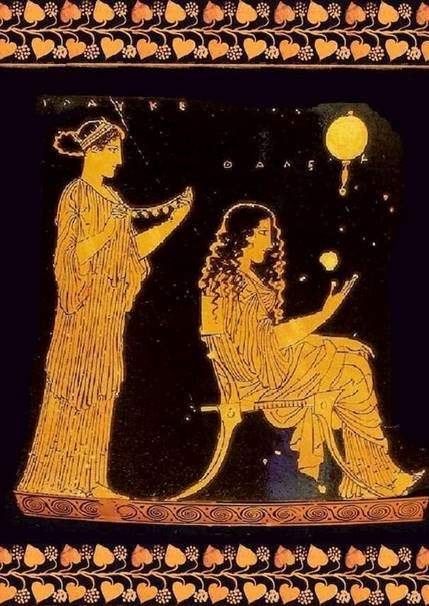Aglaonice was a woman of science who excelled in the study of astronomy in ancient Greece and was able to predict eclipses. She was the most renowned member of a group of female astronomers known as “the witches of Thessaly.” She is part of the scientific tradition that shaped astronomy, whose first and most prominent figure was Enheduanna, the Akkadian princess and daughter of Sargon I. In ancient Greece, many women played an important role in different fields of knowledge, such as Fanostrate, a midwife and physician; Pythias of Assos, a biologist and embryologist who collaborated with her husband, Aristotle, in studies on embryology and in the compilation of an encyclopedia on natural history; Theano of Croton, a Pythagorean to whom the treatises on the golden ratio are attributed; Agnodice of Athens, an important gynecologist; Artemisia II of Caria, a scholar of medicinal herbs; her namesake Artemisia I, also queen of Caria and captain of a fleet; Aspasia of Miletus, philosopher, logographer, and teacher of rhetoric. Among the last scientists of antiquity, two particularly important ones stand out, both born in cosmopolitan Alexandria: Maria of Alexandria, an alchemist and scientist who was essential to the development of chemistry, and Hypatia of Alexandria, a mathematician and astronomer, among other women of remarkable talent.

Aglaonice of Thessaly
(Aglaonica / Aganice / Aganica)
b. Thessaly — d. c. 60 BCE
Period of activity: 115 BCE — 100 BCE
Geographical classification: Europe > Greece
Socio-cultural movements
Antiquity > Greek culture > Hellenistic period
Groups by dedication
Scientists > Mathematicians
Scientists > Astronomers
Context of feminine creation
Review
Known as "she who makes the moon disappear", she is mentioned in the writings of Plutarch and in the scholia of Apollonius of Rhodes as an astronomer and as the daughter of Hegetor (or Hegemon) of Thessaly. However, her scientific authority was called into question because of the ideas transmitted by Aristotle. Thus, her supernatural powers were preferred to her mathematical and celestial observation skills, which enabled her to predict the time of a lunar eclipse. She is now considered the first European astronomer on record.
Activities
Justifications
Biography
Daughter of Hegetor (or Hegemon), she lived in Thessaly and it is deduced that she studied in Mesopotamia, as she knew perfectly the cycles of the eclipses of Saros, which the Chaldean people knew, and with which she could predict, from the Babylonian tablets and the observation of astral movements, the lunar eclipses with great precision for the time.
Aglaonice developed her activity together with other women who together were called "the witches of Thessaly". A land that was known to be home to some of the most powerful sorceresses of the time, and where an important cult of Hecate developed. The collective imagination, without the knowledge that these women enjoyed, ended up harbouring the belief that they could hide the moon. Thus, officially, she was considered a sorceress or priestess for her supposed ability to make the moon disappear from the sky, which has been interpreted as being able to predict the time and region in which a lunar eclipse was to take place.
In fact, it was her knowledge of the metonic cycle and her great mathematical ability and observation of celestial phenomena that enabled her to predict eclipses so accurately. But the ideas conveyed by Aristotle, in particular those referring to the supposed inferiority, including intellectual inferiority, of women, called into question her scientific authority, and it was preferred that she be considered a witch or a priestess.
She now occupies a place in the history books as the first astronomer in ancient Greece.
One of the craters of Venus is named Aglaonice in her honour and she is also a character in Jean Cocteau's film Orpheus, where she appears as a friend of Eurydice and leader of the League of Women.
Works
Bibliography
-Díaz Céspedes, Francisco (2020). “Mujeres en la historia de la ciencia”, Revista de Filosofía Terraustral Oeste, in Academia.edu, (retrieved on 13/04/2022) <https://www.academia.edu/>
-Katz, Miguel (2019). “AGLAÓNICE DE TESALIA ¿Hechicera o astrónoma?”, in Mujeres en la ciencia, (retrieved on 14/04/2022) <https://www.researchgate.net/publication/332438432>
-McPherson, Sarah (2022). “The Witch of Thessaly”, in Sublunary review, (retrieved on 18/01/2022), <https://www.sublunaryreview.com/home/the-witch-of-thessaly>
-S., Ana (2013). “Aglaónice de Tesalia. Astrónoma y filósofa. Mujer y ciencia”, in Mujerícolas (retrieved on 18/01/2022) <http://mujericolas.blogspot.com/2013/02/aglaonice-de-tesaliaastronoma-y.html>
-Wikipedia, (retrieved on 18/01/2022), <https://es.wikipedia.org/wiki/Aglaonice>
Didactic approach
-The figure of Aglaonice can be presented in Biology and Geology in the block dedicated to "the Earth in the universe".
-In History, in Classical Greece.
-In Classical Culture: Block Classical roots of today's world. Everyday life; Block on the continuity of cultural heritage. Literature, art and science.
-Greek Baccalaureate: Block Legacy and heritage.
-In Mathematics, when studying the Saros cycles.